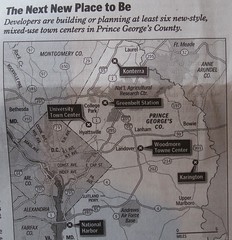The center cities and competitive advantage

Developments in Prince Georges' County, Maryland. Washington Post graphic by Nathaniel Kelso.
These days, even though the center city business district usually remains the core of a region's economic vitality--two exceptions I can think of are Detroit and maybe Baltimore--the vast majority of the population and economic activity is outside of the core.
And as generations pass, fewer people have direct connections to the core. In short, more and more people in the suburbs think about themselves within their own spheres, not in terms of the downtown.
A good example in this region is the creation of the Strathmore Music Hall in Montgomery County--not too far from DC, but providing a good reason for people in MontCo to not have to go to the center city "for culture." The same goes for the AFI Film Institute in Silver Spring.
Although generally, edgier cutting edge programming tends to locate within the core of a region in the center city. This may be a little less true in the DC region, because the big government orientation that yields from the location of the central government tends to trickle down and taint thinking and creative energy across the board.
What are the city's competitive advantages? I argue that there are five:
1. Historic architecture;
2. Place-positive urban design/livability/walkable neighborhoods;
3. History, authenticity, and identity;
4. A rich transit infrastructure that allows for efficient mobility that is not dependent on the automobile;
5. The steady employment engine of the Federal Government.
Because of the subway system, and the increased reliance on the automobile generally, and in the region's suburbs particularly, going forward, DC's competitive advantage rests upon mobility that is not dependent on the automobile.
So land use planning and transportation planning and capital improvement planning and legislative policy and regulatory policy needs to be reconciled so that always the decisions and investments support the strengthening and extension of DC's competitive advantages.
As the article in today's Post makes clear, "Ambitious Project Is Planned in Laurel," developers in the suburbs are capturing the lessons from what makes places exciting, lessons that they learned from the center cities, and making places that further disconnect suburban denizens from caring about the city or going there much.
For the most part, those developments are greenfield, and illustrate that too often, new urbanism is really new suburbanism.
Old urbanism, focused on revitalizing and repopulating the center city, is the way to go.
Labels: urban revitalization



0 Comments:
Post a Comment
<< Home